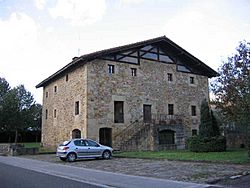County of Durango facts for kids
Quick facts for kids
County of Durango
Durangoko Merinaldea
Merindad de Durango |
|||||||||
|---|---|---|---|---|---|---|---|---|---|
| c. 1050–1212 | |||||||||

Elizates and town that composed the County of Durango
|
|||||||||
| Status | Part of the Kingdom of Pamplona, then incorporated into the Lordship of Biscay | ||||||||
| Capital | Durango | ||||||||
| Government | County | ||||||||
| Historical era | Middle Ages | ||||||||
|
• Established
|
c. 1050 | ||||||||
|
• Annexation to the Lordship of Biscay
|
1212 | ||||||||
|
|||||||||
The County of Durango (called Durangoko Merinaldea in Basque) was an old political area. It's now known as Durangaldea in the Basque region of Biscay. This county included all the towns and special villages called elizates.
Elizates followed a local law called Foral law, while towns had their own rules. Durango was a vassal state (meaning it was loyal to a bigger kingdom) of the Kingdom of Pamplona. Later, in the 1200s, it became part of the Lordship of Biscay. It has been part of Biscay ever since. The main city of the county was Durango.
Contents
History of Durango County
The first time we find a record of Durango as an organized area was around the year 1050. A person named Eneco Lupiz was put in charge of the lands of "Biscay and Durango."
It was mentioned again in 1053, this time spelled Duranko. The County of Durango was also linked to the Kingdom of Navarre, just like the County of Álava.
During the 1000s, the lands of Durango and the Lordship of Biscay were often fought over. They kept switching between the kingdoms of Castile and Navarre. In 1200, King Alfonso VIII of Castile attacked the County of Alava. He also surrounded the city of Vitoria.
Alava and Durango were finally taken over by Castile. In 1212, King Alfonso VIII of Castile added the County of Durango to the Lordship of Biscay. He gave it to Diego López II de Haro as a reward for his help in the Battle of Las Navas de Tolosa. Even after this, Durango still managed its own money and politics, even though it was now part of the Lordship.
Durango County's Territory
The County of Durango was made up of twelve elizates and four towns. These places cover the same area that Durangaldea does today. Durangaldea is a region in the province of Biscay and is the successor to this old county.
The elizates were:
- Abadiño
- Berriz
- Mallabia
- Mañaria
- Iurreta
- Garai
- Zaldibar
- Arrazola
- Axpe
- Apatamonasterio
- Izurtza
- San Agustin-Etxebarria
The four towns were:
In 1630, Elorrio took over the elizate of San Agustin-Etxebarria. Today, the elizates of Axpe, Arrazola, and Apatamonasterio are joined together. They now form one town called Atxondo.
Political Institutions
The County of Durango had special places where its leaders met.
The Audience House

The regular meetings for the leaders of the elizates and towns happened in a place called the Audience House. The first Audience House was in the Kurutzesaga area of Durango. It was known as "the Old Audience." There were some disagreements about who owned it, the county or the town of Durango.
In 1578, long after Durango became part of the Lordship of Biscay, a new place was bought. This was the House of Astola. Meetings started happening there instead. This house was built in 1570, replacing an older one that had burned down. Some of the county's officials lived in the House of Astola. It also had the county's prison.
The Foral Field
Special, important meetings for the county's leaders took place outdoors. They met in a field between two small churches, San Salvador and San Clemente. This field is in the Gerediaga area of Abadiño.
The leaders would sit on stones arranged in a half-circle under a large oak tree. The building where these meetings happened is still there today. The government of Biscay has recently fixed it up. The original oak tree was lost around the 1700s.
See also
 In Spanish: Merindad de Durango para niños
In Spanish: Merindad de Durango para niños
- Lordship of Biscay
- Durango, Biscay
- Durangaldea


